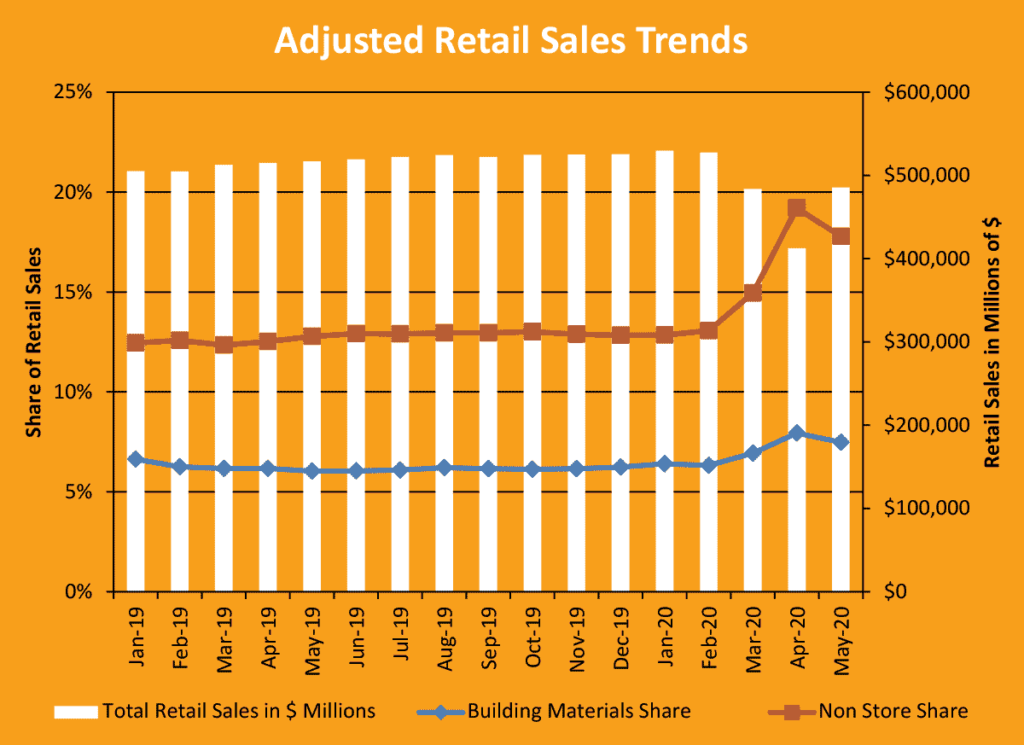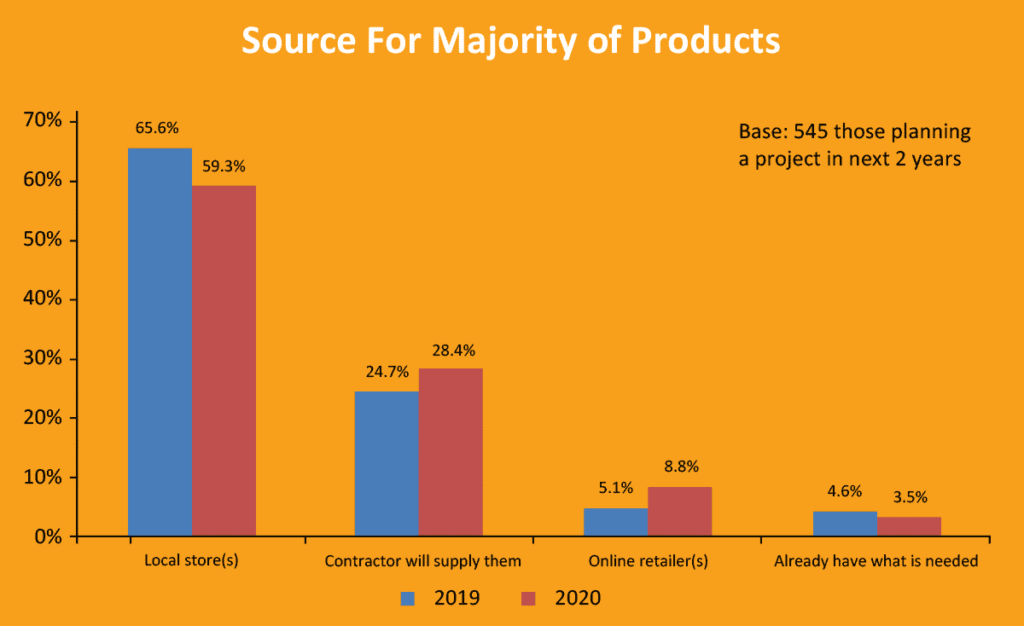Even before COVID-19 hit our shores, much of American commerce has been trending toward digital purchases. According to recent U.S. Department of Commerce quarterly e-commerce figures, consumers spent $602 billion online with U.S. merchants in 2019… up 15 percent from 2018. Much of that can be attributed to the success of online grocery retailers such as Walmart and Amazon, as well as shoppers choosing to make other retail purchases online rather than in a brick-and-mortar store.
Early 2020 economic figures show that COVID-19 is not only hyper-accelerating e-commerce trends, but is irrevocably changing the way people shop and research purchases… in ways that will be felt for decades. According to Consumer Specialists — a research firm specializing in the home improvement market — preliminary U.S. Census Bureau figures show that online retail (as a percentage of total U.S. retail sales) exploded from 12 to 18 percent between January and May 2020.
Building product and home improvement manufacturers — who traditionally rely on point-of-purchase sales — can’t afford to ignore this sea change toward digital.
As purchasing decisions are happening sooner — and more often in the digital realm — building product manufacturers stand to benefit greatly by stepping up their ‘digital game.’

An Opportunity for Home Improvement
Despite a 10.5 percent decline in total US retail sales this year due to the COVID-19 shutting down many parts of the U.S. economy… home improvement sales have continued to hold strong. In fact, according Consumer Specialists, preliminary Census 2020 retail sales figures (adjusted for seasonality) show that home improvement sales YTD through May actually rose 6.3%.
What this data demonstrates is that — in the midst of an economic downturn that has caused record unemployment and financial instability — home improvement maintains a strong place in the U.S. economy. And has even gained market share, as more people work from home and shelter-in-place. While concerns over convenience and social distancing continue to guide purchasing decisions… there is a huge opportunity for building product manufacturers to profit by recalibrating their approach to e-commerce.
In an economy where retailers can quickly move customers through the sales funnel with a couple of clicks or keystrokes, a question that begs to be answered is, “Are building product manufacturers leaving money on the table by relying on point-of-contact sales?”
Perhaps a more important question then, “Is your company doing everything it can do to thrive in a digital environment and convert customers digitally?”

Home Improvement Sentiment Growing Toward Digital Purchases
Just as consumers are growing more comfortable doing their food, clothing and furniture shopping online… there is evidence that home improvement customers are planning on making their purchasing decisions online more often.
In a just released Consumer Specialists survey regarding the impact of COVID-19 the future points to more online sales. In the survey “those planning home projects” are expecting to get the majority of their product online — has grown from 5.1 percent in 2019 to 8.8 percent today. The same study shows that there is strong growth in using online as a “source for information” on projects. In fact, a dominant 63.5 percent of those surveyed are turning to the Internet as a source of information in making building product purchasing decisions in 2020… compared to 51.3 percent in 2019. While purchases “based on contractor recommendations” remain a strong information source for purchases, the Internet is clearly the number-one source of information… by which home improvement purchasing decisions are being made.

It was once thought that clothing was too personal of an item to be sold successfully online, however, retailers have overcome this challenge. With compelling images and product videos. Generous return policies. And detailed product summaries that arm the customer with more information than the typical salesperson. If clothing sales can successfully cross the digital divide, building and home improvement sales – which have seen a rise in recent demand – can accomplish the same thing with the right strategy.
Making Your Building Product Brand More Attractive for Online Sales
Here are a few ways building product companies can improve their online engagement with customers:
- Make the sale sooner. It’s now possible to build virtual showrooms that reduce the need for POP and trade show experiences. When you’re able to physically show contractors and influencers the look, relative size, durability and thickness of the building products they are considering purchasing… your company may be able to win them over from a distance. And allow you to use omnichannel marketing for engaging potential customers sooner and more often.
- Improve your digital presence. In a digital selling environment, your website or virtual showroom may offer the only opportunity to interact with a customer. It’s best to make these sites as informative, illustrative and interactive as possible. Make sure to utilize high-quality photography and avoid sluggish page-load times. Just as a retail store changes its displays from time to time — to keep audiences engaged — be sure to update your content regularly. Ensure your sites and landing pages are mobile-responsive. Users who have a negative experience are 62 percent less likely to purchase from you in the future. So it is important to make sure your offerings are as impressive via smartphone as they are from a desktop.
- Redouble your content marketing efforts. In the world of B2B sales, content marketing — blogs, thought-leadership pieces, testimonials and editorial content — is king. You’re not just charming visitors to your site and hoping they’ll buy something. Rather, you’re broadcasting to the customer that you are sensitive to their needs, understand your industry and have a ready-made solution to solve their problems. Content marketing can be interesting, funny, persuasive or engaging… but it should always be useful.
Conversion rates are nearly six-times higher for content marketing adopters than non-adopters. Content marketing also costs 62 percent less than traditional marketing and generates about three times as many leads. Word-of-mouth marketing — in the form video testimonials and case studies — are especially useful in winning over anxious buyers.
In the wake of COVID-19, where so much of our economy relies on digital conversations, it is important for building product manufacturers to improve the ways they communicate online. Click here to learn more about the full research paper on “How COVID-19 Is Reshaping The Home Improvement Market.” And for content marketing strategies to help your building product brands company excel in a digital environment, visit kleberandassociates.com.




